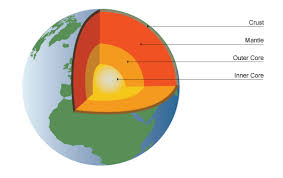Description

You probably know that the inside of the Earth is made out of a several layers of rocks at very high temperature and pressure. You have also probably seen many figures depicting the inside of our planet, but how do we know it is like that? Nobody, but Jules Verne fictional characters, has even been inside the Earth.
You hare likely to have heard of seismographs and how they are used to detect Earth Quakes. Did you ever wonder how using data collected from these devices in the UK one can tell the precise magnitude and location of an earthquake that took place on the opposite side of the Earth?
How can geophysicists detect pockets of oil several kilometres below the earth surface, without digging a hole?

What are shot gathers sometime seen in books or TV programs? What do they correspond to and what are they used for?
The answer to all these questions are quite simple: they all use the properties of waves inside the earth.

The aim of the project is to study seismic waves, how they propagate and reflect on boundaries and inhomogeneities and how the detection of these waves can then be used to determine the properties of earthquakes or determine the nature of irregularities deep into the earth, like near the very centre of the Earth, or closer to us, like oil reservoirs for example.
We will start by studying the linear theory of elasticity and use it to study the propagation of waves inside a solid. We will see that there are 2 main types of waves, so called pressure waves and shear waves and that, even in the same material, they propagate at different speed.
We will then study how such waves bounce on boundaries like the earth surface or inhomogeneities in the material.
The work can be exclusively analytical, but students who enjoy doing numerical work can also solve some equations numerically using programs written in Python, Matlab or any programming language of their choice.
Prerequisites
- Analysis in many variable II (MATH2031)
- Taking Continuum Mechanics IV (MATH4081) is recommended but not compulsory
Resources
- Introduction to Continuum Mechanics David J. Raymond.
- Seismology by Nick Rawlinson
- Theory of Elasticity: Course of Theoretical Physics. L.D. Landau, E.M. Lifshitz, A.M. Kosevich and L.P. Pitaevskii Butterworth-Heinemann, 1984
- A Treatise on the Mathematical Theory of Elasticity A.E.H. Love New York : Dover Publishing, 1944.
- Basics of Seismic Wave Theory Gerard T. Schuster
- Quantitative Seismology (Second edition) by Keiiti Aki and Paul G. Richards (ISBN 978-1-891389-63-4).(2009)
- Fundamentals of Seismic Wave Propagation by Chris Chapman. CUP (2010)
- Fundations of Mathematical Physics Sadi Hassan: Prentice Hall (1991)
- Several papers available from the web